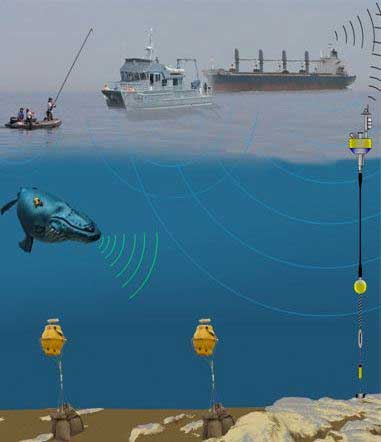Ocean Ecosystem and Resources : Status, Trends, and Linkages
Migration Corridors and Other Region-wide Features
In addition to ecologically rich areas, other important places in the Mid-Atlantic region’s ocean ecosystem include migration corridors, structurally complex habitats, places where prey are known to aggregate, and areas that provide connectivity among habitats.
Studies of Mid-Atlantic Migrations
The Mid-Atlantic ocean is known to be important for the migration of many marine mammal, bird, sea turtle, and fish species. Understanding the exact locations where and times that these key marine species use the Mid-Atlantic region for migration is complicated. Most of our observations of marine life are “snapshots” in time and space. Several research projects are attempting to better characterize the migratory activities of marine species in the region. For example, recent work by the Biodiversity Research Institute in the Mid-Atlantic describes observations of almost 48,000 cownose rays in the summer and fall of 2012-2013 from high-resolution aerial video surveys (Williams et al. 2015). The authors of this study point out that the unexpected detection of such a massive migration is a reminder of how little we know about the migratory activities of many marine animals.
In some areas of the Mid-Atlantic ocean, passive acoustic monitoring (PAM) is being used to “listen” for the signature noises produced by marine life. Because PAM can be deployed for long periods of time, it helps fill in the gaps in our other marine life observations and contributes to a more complete understanding of marine life movements. The Bureau of Ocean Energy Management is contributing to PAM studies offshore Maryland and Virginia to better understand marine mammal use of the ocean environments.
Another tool that can be used to track the movements of marine life is satellite telemetry from tags attached to animals. An example of this type of research is a collaborative project by the Sea Duck Joint Venture to tag and track black scoters, surf scoters, white-winged scoters, and long-tailed ducks, called the Atlantic and Great Lakes Sea Duck Migration Study. From the telemetry data, scientists could be able to identify important habitat areas and the annual migration patterns for these four species.
Illustration of passive acoustic monitoring system for tracking locations of marine mammals. (Credit: Michael A. Thompson, SBNMS)
ROA Linkages
The following sections of the ROA are closely related to the Migration Corridors and Other Region-wide Features section:
Selected Sources of Further Information
Endangered Species Critical Habitats (USFWS)
Tracking Marine Mammals with Passive Acoustics (NOAA)
Biologically Important Areas Map (NOAA)
Satellite Tracking of Diving Marine Birds (Biodiversity Research Institute)
Atlantic and Great Lakes Sea Duck Migration Study (Atlantic Coast Joint Venture)
Mid-Atlantic Wildlife Studies: Distribution and Abundance of Wildlife along the Eastern Seaboard 2012-2014 (Biodiversity Research Institute)

